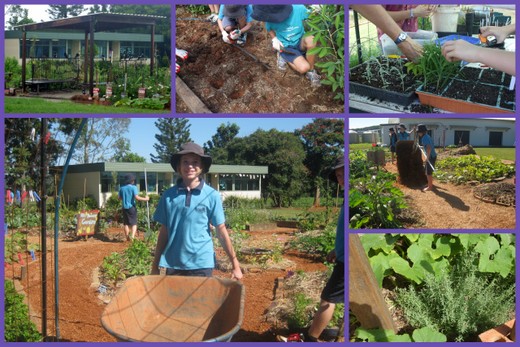North Arm Kitchen Garden Program
Students work in a beautiful and abundant school garden growing and harvesting food for the kitchen lessons. Using the spacious and purpose-built kitchen facilities, students prepare healthy meals to eat together. Students learn about where food comes from, empowering them to make responsible and healthy food choices. Working in the garden gives them an understanding of how long it takes to grow healthy food.
Pick of the Crop has supported our program for the last two years with funding and resources. Pick of the Crop is a whole school eating initiative increasing opportunities for Queensland primary school children to learn about and eat more vegetables and fruit. It is owned and developed by Health and Wellbeing Queensland with support from the Bowen Gumlu Growers Association and Bundaberg Fruit and Vegetable Growers.
A word from our Garden Specialist (Marena Bequir)
The North Arm Kitchen Garden Program is a cherished part of every student's learning journey at North Arm State School. More than just a garden, it is a space where students cultivate a deep appreciation for nature while developing valuable lifelong skills.
Through hands-on garden lessons, students are introduced to the beginning principles of permaculture. They learn to garden organically, sustainably, and in harmony with the local seasons. Students learn how to plant, propagate, mulch and identify plants.
A unique feature of the program is its integration of gardening and cooking. Students are actively involved in planning, planting, nurturing, and harvesting produce. These ingredients are then used in their Kitchen lessons.
Over time, students build a meaningful relationship with the school garden. It becomes a space for reflection, exploration, and calm—a place they often return to when they need to reset or simply want to see what's growing or happening.
Families and community members are always encouraged to be involved in our program, enriching the garden, and the students learning.
The garden is the heart of the school, where students' curiosity, awe and love of nature shines!
A word from our Kitchen Specialist (Lis Anderson-McColl)
Students participate in an 80 minute kitchen lesson, preparing and sharing a meal with classmates. Parents are encouraged to assist in classes. Meals are planned around the school garden with a strong emphasis on increasing vegetable intake. All recipes can be found at the link at the bottom of this page so that meals can be cooked at home. Some of the elements students are learning whilst in the kitchen include:
- Etiquette: table setting, table manners, serving food to others, eating and talking with classmates
- Culture and global connections; history of certain foods and cultures in our country as well as the rest of the world
- Maths: dividing up dough, portioning, addition, subtraction, measuring, fractions
- Literacy: reading and interpreting recipes, procedural genre
- Working in groups/teams: cooking and cleaning up in groups
- Hygiene: personal (hands, hair) and kitchen (cleaning), cooking for others
- Safety, particularly using sharp knives
- Different skills: knives, dough, mixing, folding, kneading, dicing, slicing
- Nutrition: of ingredients e.g. Bunya nuts are low in fat and high in carbohydrates compared with tree nuts
- Seasonality of foods: preserving, nutritional and economical value. Making herbal teas and drying turmeric
- Independence and self-esteem: being able to prepare meals for the family rather than just packet mix cakes, experimenting with and trying new foods.
- Science: change of state, gases, solids, liquids, oxidation.
- Health: using the Australian Guide to Healthy Eating, food groups, nutrients, focus on increasing vegetable intake, interpreting nutrition labels.

Recipes from the program are also available - download the PDF files from the "Forms and Documents" Page to cook with your family at home.